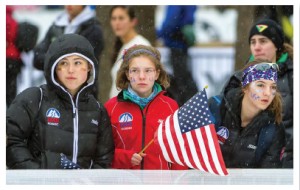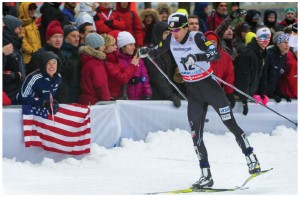 “It was like, man—this is the coolest sport.”
“It was like, man—this is the coolest sport.”
Andy Newell is leaning forward in a chair at the Stratton Mountain School’s library, recalling the chain of events that has taken him to this point.
The Shaftsbury native, now 28, was skiing by the age of three, racing by the time he was five and then became a member of the Bill Koch Ski League on Prospect Mountain, the cross-country ski center in Woodford. Koch, a Brattleboro native, won a silver medal in the 1976 Winter Olympics, as many will remember, and remains to this day the only North American man to have earned an Olympic medal in Nordic skiing. That’s a short list Andy wants to join, and he has a real chance of doing so.
When he arrived at the Stratton Mountain School as an eighth grader back in 1997, he started to really focus on cross country Nordic racing, he says, and never looked back.
“Going to SMS at a young age allowed me to realize I wanted to be an Olympic skier and that it was possible,” he says.
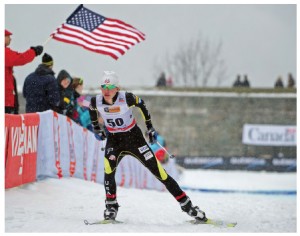 Ever since graduating from SMS in 2002, Newell has “given back” to the school he credits with helping shape him into the world-class competitor he has become. He has returned to the school every summer during his sport’s off-season, to work and train with current SMS skiers, and pass along some of his wisdom and experience. That experience hails from some truly rarified air—he’s been a member of the U.S. Olympic ski team in 2006 and 2010, and has three World Cup podium finishes plus a U.S. championship title in 2008 under his belt.
Ever since graduating from SMS in 2002, Newell has “given back” to the school he credits with helping shape him into the world-class competitor he has become. He has returned to the school every summer during his sport’s off-season, to work and train with current SMS skiers, and pass along some of his wisdom and experience. That experience hails from some truly rarified air—he’s been a member of the U.S. Olympic ski team in 2006 and 2010, and has three World Cup podium finishes plus a U.S. championship title in 2008 under his belt.
It was one thing to see the advantages of having an elite team to go along with the other school squads— which also includes another small group of SMS “post grads”—but quite another to actually make it happen.
This year though, there’s a difference. SMS has organized a six-member elite Nordic cross country ski team club designed to give the athletes the support, financial and otherwise, to make the dream of Olympic and World Cup glory that much more plausible. With some help from T2, a Hanover, New Hampshire-based nonprofit organization, plus some home-grown fund-raising, SMS has expanded its existing Nordic program—originally launched in 1972—to give these elite skiers a coach and an off-season home to train from.
In return, they give back to SMS through encouraging younger skiers, being role models and setting the standards, says Sverre Caldwell, the school’s Nordic program director and head coach of the SMS Nordic girls’ team.
“It’s something I always wanted to do,” he says. “We’ve always encouraged alums to come back and train with us; the problem was we couldn’t commit to coaching them.”
There is, after all, a slight difference in skill level between most high school age skiers, no matter how talented, and those who have already proven themselves at the upper reaches of the college ranks and are hungry for more.
It was one thing to see the advantages of having an elite team to go along with the other school squads— which also includes another small group of SMS “post grads”—but quite another to actually make it happen, Sverre Caldwell says.
“We announced the program and hired a coach,” which turned out to be Gus Kaeding, an SMS alumnus who had been a teammate of Newell’s, Caldwell says.
Selecting the team members was something of an “amorphous” process, he adds. “We didn’t do formal applications, we just sort of talked to people who were interested.”
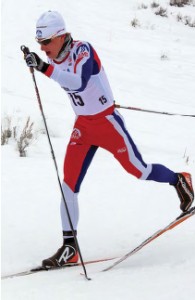
Nationals in Soldier Hollow, Utah, placed 7th
in the skate sprint. PHOTO: TOKOUS.COM
Andy Newell and Skyler Davis, both SMS alumni and U.S. Ski Team members, were obvious picks, and they gave the effort instant credibility. Then came three former members of the Dartmouth College ski team: Erika Flowers, from Bozeman, Montana, Sophie Caldwell, from Peru, Vermont, and Sverre’s daughter, along with Eric Packer, from Anchorage, Alaska, who had skied for the Big Green at Dartmouth. Jessie Diggins, who hails from Afton, Minnesota, and also a member of the U.S. Ski Team, arrived shortly afterwards to round out the squad—she had been coached the year before by Kaeding and followed him to the Stratton team.
Once they selected the team and word got out, a virtuous cycle of good events followed.
Stratton Mountain Resort provided free housing for the athletes for the spring and summer. Then, some additional sponsors stepped up. Along with SMS and the Stratton Corporation, r.k.Miles, the lumber and hardware store based in Manchester, and Swix, a maker of ski equipment, agreed to help. Then, the T2 Foundation came in as the title sponsor, Caldwell says.
A ski-a-thon fund-raiser where athletes skied 100 kilometers raised more money for their travel expenses as well, he says.
Elite club teams of the sort Stratton Mountain School has put together this year, are more and more in evidence, with the encouragement from officials with the U.S. National Ski Team. It’s one way to boost their skills and training, because putting in the time and effort to qualify for Olympic and World Cup levels is expensive. Most athletes and their families can’t support the full financial cost, Caldwell says.
“We’re talking about people in their early twenties who are just out of college,” he says. “They don’t have a lot of money. So what we’re doing is helping (six) people make it manageable—so that they are not totally relying on their parents.”
For instance, it costs about $15,000 a year in travel expenses to cris-cross North America plus the few trips to Europe that are necessary. Add in coaching and room-and-board and the cost quickly gets prohibitive, he says.
However, it’s not all take and no give either. “There’s a huge benefit for our high school skiers,” Caldwell says. “It’s like they’re at a U.S. team training camp—they get to see these guys and see how fast they are and how hard they work—it raises the top of the box. It expands their range.”
Erika Flowers is one of “these guys.” The world of Nordic skiing is a small one. Erika came east to ski at Dartmouth, where she met Sophie Caldwell, the NCAA 2012 female cross-country skier of the year, and an SMS grad. Once Flowers decided she wanted to stick with Nordic skiing for at least a little while after college, she began exploring her options, she says.
“Sophie mentioned that SMS had been wanting to start an elite team and I talked to Sverre about the potential for a professional ski program based out of Stratton,” she says. “Ultimately, the SMS T2 team offered the best combination of awesome training facilities and opportunities, a good location, great teammates and a coach who would push me, and solid racing and training support.”
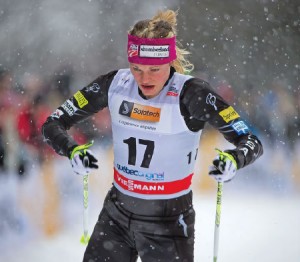
up with Kikkan Randal to win the team sprint, the first-ever U.S. relay gold. PHOTO: FLYINGPOINTROAD.COM
The “training support” is not for the faint of heart. Typically they train six days a week, with a “recovery day” cycled in. In the summer, that means they are out a lot on roller skis—sort of a cross between a skateboard and roller skates on steroids. Used with ski poles, they are the closest you can come to replicating the motions of Nordic skiing, and the team’s idea of a good day might be to roller ski up the Stratton Mountain access road—a distance of about five miles or so—then pile into the team van and head down to the starting point at the base of the access road where it meets Route 30 in Winhall, so they can roller ski five miles uphill again. Then there’s the usual combination of weightlifting, cycling and maybe some yoga and swimming thrown in for good measure, Flowers says.
Five hours of training a day is how champions are made, Andy Newell observed.
“As a top international racer we need to be training over 800 hours a year so we cover a lot of different modes of training,” he says. “Skiing is so aerobic—that’s the part that requires the long hard workouts and the big training hours. It’s common to do a two to three and a half hour run or ski in the morning and go out again for an afternoon session.”
It takes years of systematic training to become a top endurance athlete, Sverre Caldwell explains. Summer is a time for base training with high volume, then the intensity is raised during the fall. During the winter, things back off a bit because of the demands from racing and traveling.
Or, as Gus Kaeding, the team’s coach puts it, by the time the actual competitions begin, “the hay has to be in the barn. In a fitness sport, you can’t build endurance in a short amount of time,” he says. “It really takes all summer.”
The process of selecting the team members might have been somewhat amorphous, but a lot of thought went into it, Kaeding says.
“We were looking not only for the best athletes, we were looking for the best people,” he says. “Since we work so closely with the school, it’s super important that you can depend on these people to be perfect role models and not have to worry about them.”
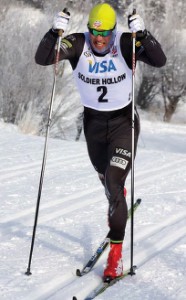
Soldier Hollow, Utah. He placed 4th in the
classic sprint and 8th in the skate sprint.
PHOTO: TOKOUS.COM
That combination of athleticism and maturity isn’t always easy to find, he adds.
Six seemed like a nice, manageable number, divided evenly between men and women. There may have been another, more prosaic reason—six was about as many skiers as can fit comfortably with their gear into the team van, Kaeding says, not totally unseriously. More skiers means at least one more van.
“Right now we have a small program and everyone gets a lot of attention,” he says. “They’re improving fast. I think we’ll keep it at that level for awhile.”
So what does a coach—especially one who is a contemporary or, at best, only a few years older than his squad members—have to teach to a group of already elite skiers?
Some of it can be technical, but a big part of coaching a team like this involves the mental factors, Kaeding says. Each athlete is an individual case.
“The biggest thing is getting to know the athletes and approaching it not like it’s football—you know, yelling at someone like it’s rah-rah-rah,” he says. “Maybe they get too tight in the head and freak out before the race. These guys have been doing this at a very high level for a long time and they’re plenty smart, so I’m basically going to learn as much from them as they are from me.”
And while competitive skiing is an individual sport, building the team concept is also important, he adds. “You can battle your own demons, but it’s nice every once in a while to be uplifted by others,” he says.
Erika Flowers shares that assessment. Part of it’s the simple desire to keep up with—or out-do—your teammates on a training exercise or in a competition. It’s made her faster and more aggressive, she says—even skiing with the SMS students provides motivation. After all, who wants to get beat in a sprint by a high school student, she asks.
“I think we do a good job of pushing each other and using each other’s strengths to improve our own weaknesses,” she says. “Skiing with the SMS students has helped me a lot with my technique and speed work. I pay a lot more attention to how I am skiing when I know someone is following me and trying to match my technique.”
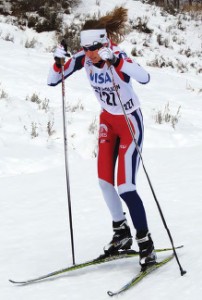
Soldier Hollow, Utah. She placed 8th in the 10
km skate. PHOTO: TOKOUS.COM
The team spent most of the summer at Stratton training, then headed west for more training in Utah in the fall. From there, some went to Europe, while others went north to Canada. All were pointing towards a World Cup race in Quebec in December 2012.
“They all want to give back to the community,” Kaeding says. “They’ve gone above and beyond that. It’s something you don’t see the returns on until way down the road.”
And for Caldwell, the goals are two-fold—producing athletes who compete on an international level as well as expanding the grassroots programs to draw in new and younger skiers.
“We want Stratton and southern Vermont to be known as an area that helps produce some of the best cross country skiers in the world,” he says. “It’s really exciting when there is a clear path to success; start in the local youth ski programs, work hard, and the sky really is the limit.” ◊
Andrew McKeever is a freelance writer from Sunderland.
